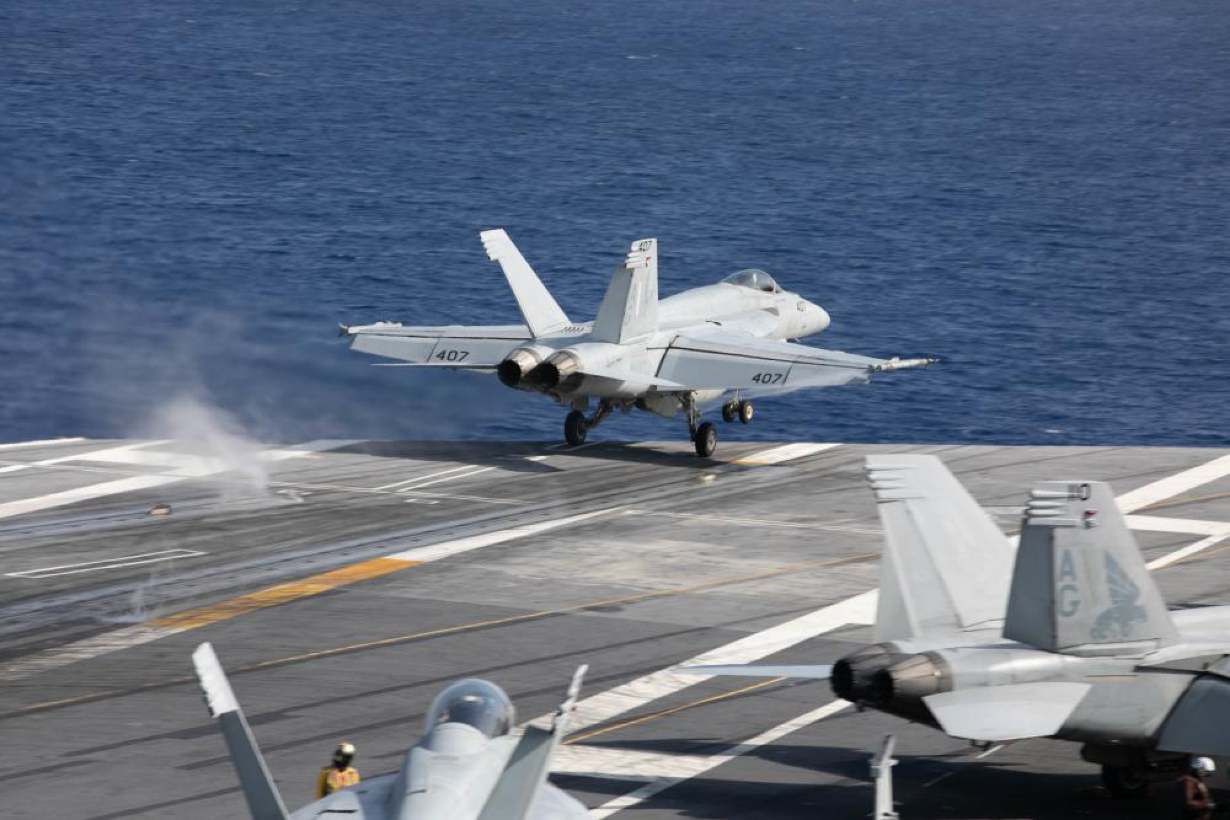Weeks after a group of US Navy fighter jets returned home following months of intercepting Houthi missiles, another contingent has been sent to the Middle East amid fears of an imminent Iranian offensive.
In an effort by the Pentagon to protect American troops and help defend Israel against potential attacks by Iran and its proxies, about a dozen F/A-18 fighter jets from the aircraft carrier Theodore Roosevelt have flown to a military base in the Middle East, an American official told the media.
According to the official, the F/A-18s and an E-2D Hawkeye surveillance aircraft departed the carrier in the Gulf of Oman on August 5 and arrived at the unidentified military base in the region.
The development comes after reports suggested that the USS Abraham Lincoln Carrier was heading to the Middle East to relieve the USS Theodore Roosevelt which has been sailing in the region for a while.
Bracing for an attack, the US also stated that it was deploying additional naval fighter jets, navy cruisers, and destroyers that could shoot down incoming ballistic missiles. However, it is intriguing that the naval fighters have been stationed on a land base given that the US CENTCOM (United States Central Command) already has fighter jets like the F-15E Strike Eagle, the F-16 Fighting Falcons, and the A-10 Warthogs in the region.
Moreover, the deployment of naval fighters comes even as a dozen F-22 Raptors are believed to be on their way to the Middle East. According to reports, these Raptors would be deployed to the same base where the Super Hornets have been stationed, indicating that their deployment was likely to be temporary.
The official told the media that the length of time the aircraft will stay together at the base is unknown. It could depend on what happens over the next few days.
The F/A-18 Super Hornets were previously deployed to the region to shoot down missiles fired from Yemen-based Houthi militias in the wake of Israel’s bombing campaign in Gaza.
The Super Hornets also conducted multiple strikes against the Houthis along with their British counterparts. In January, for example, the F/A-18s from the USS Eisenhower and other ships shot down two anti-ship cruise missiles, a ballistic missile fired by the Houthis, and 18 drones during one firefight.
U.S. Secretary of Defense, Lloyd Austin has ordered the Deployment of the USS Abraham Lincoln (CVN-72) and the Ships of Carrier Strike Group 3 to the Middle East amid Escalating Tensions between Israel and Iran. Secretary Austin also ordered the Deployment of an additional Air… pic.twitter.com/rTED9DyVRz
— OSINTdefender (@sentdefender) August 2, 2024
According to reports, the carrier USS Abraham Lincoln, which is now headed to the Middle East, is carrying EA-18 Growlers, F/A-18E/F Super Hornets, F-35C Joint Strike Fighters, E-2D Hawkeye airborne early warning and control aircraft, MH-60R/S Seahawk helicopters, and C-2 Greyhound carrier delivery planes.
The deployments come after President Joe Biden promised “new defensive US military deployments” to the region last week, which was received favorably by Israeli Prime Minister Benjamin Netanyahu.
The United States is preparing for Iran to act on its threat to retaliate for the assassination of Ismail Haniyeh, the Hamas leader in Tehran, which has been attributed to Israel.
“(United States Secretary of Defense, Lloyd) Austin has ordered adjustments to U.S. military posture designed to improve U.S. force protection, to increase support for the defense of Israel, and to ensure the United States is prepared to respond to various contingencies,” the Pentagon said in a statement.

Iran’s Attack Imminent
Following the deaths of the senior political leader of Hamas, Ismail Haniyeh, in Tehran, and top Hezbollah commander, Fouad Shukur, in Beirut, last week, concerns have been voiced that Iranian retribution might ignite a wider regional conflict beyond Israel’s fight with Hamas.
Israel is believed to be behind both killings after months of bloody attacks on Gaza, which have resulted in nearly 40,000 Palestinian deaths. Israel has also remained embroiled in tension with Iran and its ally in Lebanon, the Hezbollah. This has led to speculation about the possibility of a regional war involving Iran and its proxies on one side and Israel, along with its Western allies, on the other.
Iranian officials have made it clear that they will retaliate. Nasser Kanaani, a spokesman for the Ministry of Foreign Affairs, stated that the only way to bring about regional security is to “punish the aggressor and create deterrence against the adventurism of the Zionist regime [Israel].”
Captured on Telegram
Iran's Ministry of Defense released a video showing possible scenarios for an attack on Israel. In this context, Iron Dome proves ineffective.@kedmi pic.twitter.com/Wc6qHKrFSL
— Peacemaker (@peacemaket71) August 5, 2024
Military watchers and analysts have observed that it may have become essential for the Iranian regime to respond to an attack on its territory, especially after it carried out a significant aerial strike on Israel earlier this year in retaliation for the bombing of an Iranian embassy in Syria.
It is believed that Iran might execute a similar attack, with Hezbollah joining in this time as the militia exacts revenge for the Israeli strike that killed senior leader Fouad Shukur. This kind of attack could put pressure on Israel’s air defense systems, raising the chances of future missile attacks and the risk of casualties. Experts worry that this further escalation could spark a larger regional conflict.
- Contact the author at sakshi.tiwari9555 (at) gmail.com
- Follow EurAsian Times on Google News